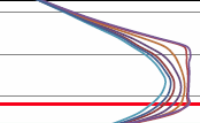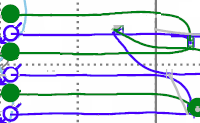10 ways to increase production before Christmas
 Exit rate. Exit rate. Exit rate.
Exit rate. Exit rate. Exit rate.
Exit rate is one of the measurements of the growth of an oil company.
This post is brought to you by Proven Reserves Exploitation Ltd., one of our information sponsors. Check out the related infographic 10 ways to increase production before Christmas - infographic
Investment is starting to flow into the oil patch. Every employee is busy looking for opportunities.
However, like year-end tax planning, it's difficult to make a big difference in a short amount of time.
?subject=Help me get my exit rate up quickly&body=Help me get my exit rate up quickly. Let's discuss ways to increase production by year end.%0D%0A%0D%0AMy name __________%0D%0AMy phone __________%0D%0AOr call Proven at 403 803 2500">Contact Proven for help in making more oil quicker.
But here's 10 ways to make a quick difference to your exit rate. Each idea costs less than half a million.
1. Shoot fluid levels
Shooting fluid levels will quickly tell you where you can make more oil. If the fluid level in an oil well is more than 1 joint, you can likely speed up the pump.
This may seem obvious, but I'm surprised how many fields I look at where the fluid levels haven't been shot for years. There is no database of fluid levels for the wells. When I check with the operations staff, they didn't know it was important.
Cost: $0.5-$1k per well
2. Run dynamometers
Among other things, a dynamometer can tell you if a downhole pump is worn. A worn pump doesn't work efficiently produces less oil than the well capacity. I've seen wells where the pumps have been worn for three years that saw an instant productivity increase after a pump change.
Cost: $1-$2k per well
?subject=Help me determine where to run dynamometers&body=Help me determine where to run dynamometers. Let's get my bottom hole pumps working at their peak performance.%0D%0A%0D%0AMy name _________%0D%0AMy phone _________%0D%0A%0D%0AOr contact Proven at 403 803 2500.">Contact Proven to learn about the benefits of dynamometers.
3. Speed up pumps
If your bottom hole pumps are in good shape and you've got fluid above the perfs, you might be able to speed up the pump stroke.
For example, increasing the pump speed from 4 strokes per minute to 5 adds 20% more production.
Cost: Free
4. Replace downhole pumps
Worn bottom hole pumps can reduce your production. If one of your oil wells hasn't had a pump change for more than a year, you might be able to make more oil by changing the pump.
Especially if an oil well has its pump stroke set "on-tap" the bottom hole pump is likely to be worn. Check it and change it.
Check the biggest wells first. If you can add 20% more production for the big wells your overall production will improve significantly.
Cost: $5-$15k per well
5. Well restarts
Look for wells that were suspended over the last few years. Can they be restarted?
You would be surprised how many wells have been suspended because the rods broke and no one thought there was money for a rod job.
I once found a well for a client that had been suspended for 4 years. Its previous production rate had been 150 bopd. We repaired the rods and put the well back on production. The one well made our client get a bonus for the year.
Cost: Free
6. Shut in the gassiest oil wells
If one well in your oil pool is very gassy, consider shutting it in. The rest of the oil wells may flow better.
You may find that all the gas that one gassy well was introducing into the gathering system was creating a high pressure drop and putting back pressure on the rest of the oil wells.
In addition to creating gathering system back pressure problems, producing a lot of gas from the pool is likely depleting the pressure in the pool prematurely. Shutting in the gassy well will save the reservoir pressure and help the others flow better. This will be a great long term affect from shutting in the gassy well.
Cost: Free
?subject=Help me reduce back pressure in my gathering system&body=Help me review the gas in my gathering system so I can reduce back pressure on my wells. Tell me how much more oil I'll make.%0D%0A%0D%0AMy name _______%0D%0AMy phone _______%0D%0A%0D%0AOr call Proven at 403 803 2500.">Contact Proven for analysis of how much extra production your make.
7. Drop the back-pressure
A well can only flow against the pressure on the well head. The higher the well head pressure, the lower the well flow.
Conduct a pressure audit along the gathering system. If there any big pressure drops, eliminate them. You'll increase productivity.
Cost: $0.5-$1k
8. Rent a compressor
This is one way to improve production especially on gas wells. If you can drop the back pressure on a well by installing a rental well head compressor, you can sometimes increase the production by 50%.
Since gas prices have been down for so long, there are many rental compressors available.
Conduct a back pressure test first to determine how much additional production you'll make.
Although this is a gas tip, it can also work for oil wells.
Cost: $15-$25k per month
9. Perf uphole zones in suspended wells
Can you perf uphole in any of the suspended wells?
Some of your suspended wells may not be restart candidates. But you might have an uphole gas zone. For the cost of a plug and a perforation, you might be able to add reserves and production quickly.
Cost: $30-$40k
10. MRL audit
This isn't a field tip -- it's a regulatory tip. If you have wells still choked by maximum rate limitation, you can likely get the restriction lifted with an application.
As of last week, good production practice applications are being approved in less than a month. If you hurry, you might get one approved before year end.
MRL Audit Cost: $10-$20k
We were successful in getting GPP for one operator even though his DIY application had failed the first time. At Proven, we know how to read between the lines. We know what the regulator needs to hear to grant an approval. And we have a money back guarantee. To see that application, click on the blue button below labelled "Get this application now".
Buy these submission docs now Subscribers get them for free?subject=Help me get GPP for all my wells&body=Help me get GPP for all my wells. Let me leverage your GPP know-how to increase production by year end.%0D%0A%0D%0AMy name _______%0D%0AMy phone _______%0D%0A%0D%0AOr call Proven at 403 803 2500.">Contact Proven for an MRL audit.
And one more flow assurance tip for good measure -- Reperf
How can you tell if the perfs in your well are still open? Scale, wax, asphaltenes or even a poor original perforating job might be blocking the perfs.
If a well isn't performing as well as you think it ought, reperforate it. Maybe you'll get more production.
Cost: $10-$20k
We've given you 10 ways to increase production before Christmas -- and one bonus. If you're too busy to get these done, call Proven. We can help you get your production up before end of year.
Tags: Tight, Polymer, Flood, Heavy Oil
 Granger Low Updated 20 Nov 2025
Granger Low Updated 20 Nov 2025

Non-meridian thermal wells
Still drilling horizontal wells N-S? Why?

Steam surfactant co-injection
Want to win? What is your competitive advantage?

Surprise! Sour gas production from a sweet thermal scheme
Dealing with surprises in the oil and gas industry. What to do next.

10 ways to increase production before Christmas - Infographic
For your wall to remind you

Using AI to reduce risk of oil and gas failure
How can you assess the risk without knowing the epic fails?

Artificial intelligence using vetted oil and gas information
Using anything else is dangerous

Your AI search history is being sold to your competitors
Your use of AI is not free

Smarter acquisitions
Video demo on using the KiP box for acquisitions

AI alerts increase the speed of innovation
AI launches oil and gas operators from rival wins

Elusive promise of ASP flooding
This one's ending

SAGD Blowdown Experiment
Shows his unexpected results

Selfie-mail: emails to myself
I send more emails to myself than to any other person.

Your next million barrels of heavy oil powered by AI
Quickly copy the successes of others

Shared: powerful side by side comparison of before and after polymer flood
Six fold oil production increase

Four ways your flood is crying for help
Can you hear it?

Great oil and gas operators don't just wing it — they focus
From uncertainty to control in One Day using AppIntel AI

Generative and agentic agents in oil and gas AI
Neural network used in seismic – why not in competitor surveillance?

AppIntel AI blog delivering over 50,000 pages views per month
Artificial Intelligence for the oil and gas industry

The making of an oil and gas AI.
Decoding the building blocks of Artificial Intelligence

Success is in the pattern not just the polymer
A preferred pattern is very important

This breaking horizontal well technology is not described in textbooks
What if you lacked the knowledge top oil operators rely on?




 Calgary, Alberta, Canada
Calgary, Alberta, Canada
 Share
Share